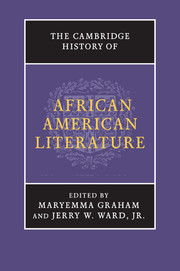Book contents
- Frontmatter
- Introduction
- PART I AFRICAN AMERICAN LITERATURE FROM ITS ORIGINS TO THE TWENTIETH CENTURY
- PART II AFRICAN AMERICAN LITERATURE IN THE TWENTIETH CENTURY
- 12 Foundations of African American modernism, 1910–1950
- 13 The New Negro Movement and the politics of art
- 14 African American literature and the Great Depression
- 15 Weaving jagged words: the black Left, 1930s–1940s
- 16 Writing the American story, 1945–1952
- 17 Geographies of the modern: writing beyond borders and boundaries
- 18 African American literature by writers of Caribbean descent
- 19 Reform and revolution, 1965–1976: the Black Aesthetic at work
- 20 History as fact and fiction
- 21 Redefining the art of poetry
- 22 Cultural resistance and avant-garde aesthetics: African American poetry from 1970 to the present
- 23 New frontiers, cross-currents and convergences: emerging cultural paradigms
- PART III AFRICAN AMERICAN LITERATURE AS ACADEMIC AND CULTURAL CAPITAL
- Bibliography
- Index
- References
14 - African American literature and the Great Depression
from PART II - AFRICAN AMERICAN LITERATURE IN THE TWENTIETH CENTURY
Published online by Cambridge University Press: 28 May 2011
- Frontmatter
- Introduction
- PART I AFRICAN AMERICAN LITERATURE FROM ITS ORIGINS TO THE TWENTIETH CENTURY
- PART II AFRICAN AMERICAN LITERATURE IN THE TWENTIETH CENTURY
- 12 Foundations of African American modernism, 1910–1950
- 13 The New Negro Movement and the politics of art
- 14 African American literature and the Great Depression
- 15 Weaving jagged words: the black Left, 1930s–1940s
- 16 Writing the American story, 1945–1952
- 17 Geographies of the modern: writing beyond borders and boundaries
- 18 African American literature by writers of Caribbean descent
- 19 Reform and revolution, 1965–1976: the Black Aesthetic at work
- 20 History as fact and fiction
- 21 Redefining the art of poetry
- 22 Cultural resistance and avant-garde aesthetics: African American poetry from 1970 to the present
- 23 New frontiers, cross-currents and convergences: emerging cultural paradigms
- PART III AFRICAN AMERICAN LITERATURE AS ACADEMIC AND CULTURAL CAPITAL
- Bibliography
- Index
- References
Summary
The 1930s in African American literary history comprised jarringly significant shifts in the style, subject matter, and direction of prose fiction. If the New Negro Renaissance of the 1920s were to be reduced to a simple, even simplistic binary, it represented a struggle between younger artists generally desiring artistic freedom, or the opportunity to create art for its own sake, and older artists and intellectuals such as W. E. B. Du Bois, Benjamin Brawley (1882–1939), Charles S. Johnson, and others who wished for the younger generation before them to see their art as part of an agenda of social and “racial” progress. This latter group could be as ambivalent as Du Bois in regarding these goals, voicing support on the one hand for works that “please,” “entertain,” and that are “good and human [stories],” while decrying works and authors who do not recognize that “all art is propaganda and ever must be, despite the wailing of the purists.” Du Bois's second view, it must be stressed, was an argument that art's beauty stems from its ability to tell the truth, and that telling the truth meant conveying experiences that the reader would recognize as the truth, or otherwise widen the expanse of what she considered truthful and real. For African American authors, Du Bois argues, telling the truth means creating art that helps in “gaining the right of black folk to love and enjoy” all the riches that surround them.
- Type
- Chapter
- Information
- The Cambridge History of African American Literature , pp. 288 - 310Publisher: Cambridge University PressPrint publication year: 2011
References
- 5
- Cited by



